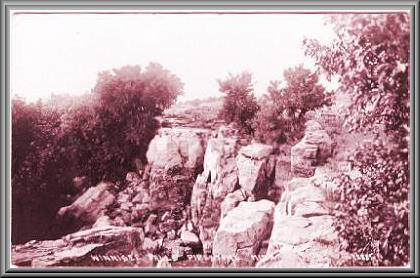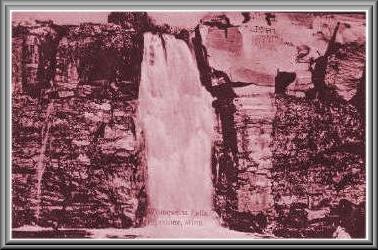The Little
Feather Center - Quarrying Workshop
Quarrying
for the Sacred Red Stone

The rock face
from an early post card (early 1900's)
|
Quarrying
for pipestone is a labor intensive and time consuming task. The proverbial
phrase, ‘Sweat, blood and tears’ would be appropriate for this endeavor.
- Chuck Derby
|
Introduction
| Quarrying
for the Sacred red stone, Catlinite, is a dying occupation.
It is very hard to find people who are dedicated to the old ways
and who will work for basically nothing to keep the Pipe alive.
There are very few quarriers today and the majority of those live
in Pipestone and carry on the traditions of their family who have
been birthing the Catlinite for at least 6 generation, since prior
to 1862.. |
|
| These
people are needed to birth the sacred Catlinite so that pipes can
continue to be made of this traditional stone. The way to reach
the stone is hard and can be dangerous. It is thankless work and
very tedious. However the rewards are in the knowledge that you
are working with something so sacred; the energies of the ancient
quarries, and that without you a timeless spiritual tradition would
be gone. |
|
| The
younger generation are urgently needed to continue this traditional
work. We hope that we can find enough people to train with our traditional
quarriers before they have passed on thus leaving a void that no-one
can fill, with the learning lost forever. This has to be done now,
and so we are setting a precedence and offering this free program
for any qualified person to participate in. |
|
|
The
program will give the history of Pipestone quarries, but more
importantly it will enable the participants to get the experience
of quarrying for themselves. If any feel that the work is for
them then they will have the opportunity to take further training
with us.
These workshops are free for all enrolled Tribal people, and are
hosted jointly by The Pipestone Catlinite Quarriers Guild and
Spirit of Peace Crafts, as well as our Center.
|
|

Old post card
of Winnewissa Falls, Pipestone National Monument (Early 1900's)
|
Our
ancestors would have encountered the same process and tasks as the modern
quarrier does. -
Chuck Derby
|
All excerpts
by Chuck Derby are from his book 'Memories of Sacred Land Comtemporary
History of the Pipestone Quarry '
This site has been designed & implemented by Dragonfly
Dezignz
Hosted by the
following organizations











